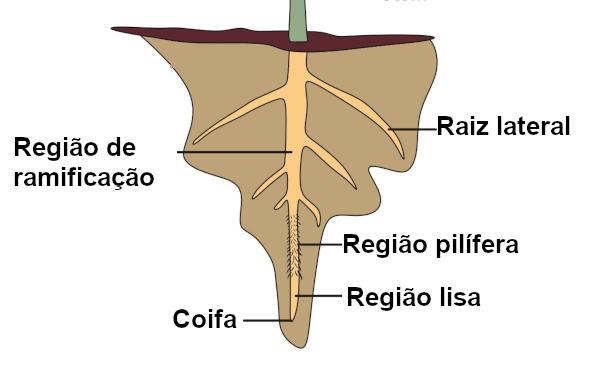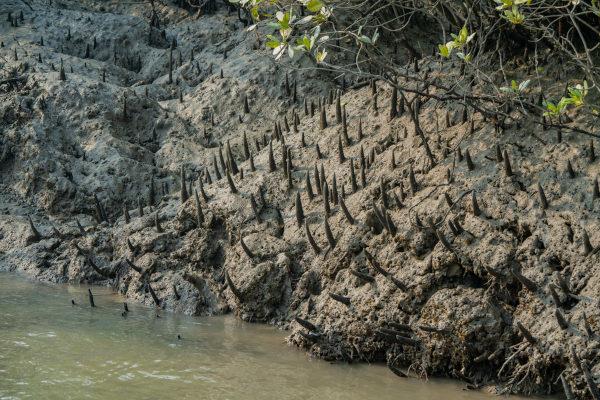THE source is a structure found in vegetables that acts mainly in fixing the plant to the substrate and in the absorption of Water and mineral salts. It is noteworthy, however, that the roots can perform other functions, such as acting as reserve organs. We can identify four main parts in them: hood, smooth region, piliferous region and branching region.
Read too: Water transport through the vegetable body
What is root?
The root is a plant organ whose main function is to plant support and the absorption of water and mineral salts, which are taken, via xylem, for the aerial parts of the plant. They originate from the radicle in the embryo and, for the most part, they do not have knots and internodes, as in the stems, do not feature chlorophyll, and the growth takes place towards the center of the Earth (positive geotropism).
In addition to the absorption and fixation functions, many roots are important reserve bodies. In the roots are also synthesized plant hormones, like cytokinin, and others secondary metabolites.

The first root that originates from the embryo is called primary. In plants with seeds that are not monocots, we have one pivoting root system, with a primary root, called the pivot root, growing towards the center of the Earth and presenting ramifications, called the lateral roots.
In monocots, the primary root atrophies rapidly and the root system is made up of adventitious roots, which form from the stem. This system is called fasciculated and it is characterized by having roots that have basically the same diameter, with none more prominent than the other.
Root parts
The root presents four basic parts: coping, smooth or stretching region, hairy or absorption region, and branching region. Let's learn more about each one below:

Coif: structure found at the end of the root that has a cap or thimble shape and acts to protect the meristematic region (in which intense cell division occurs). The hood, by protecting the meristematic region, ensures root growth, which could be harmed if microorganisms or friction with the soil would injure the region. The hood cells synthesize mucilage, which lubricates the root and ensures better penetration into the ground.
Smooth or distended region: it is a young part of the root, where no ramifications or absorbent hairs are observed. As the name suggests, this region is of distension, with an increase in cells in length. This elongation is primarily responsible for root growth in length and also ensures that the apex is pushed deeper into the soil.
Piliferous or absorption region: in it are the absorbent hairs. They are essential to ensure greater water absorption and nutrients, however, it is not the only absorption site.
Branch region: in it we have the oldest part of the root. At this point there are no more absorbent hairs. It is in this region that the lateral roots are formed, which is why it is called the branching region.
Read more: Leaf anatomy - leaf parts and functions
Classification of roots according to the environment in which they develop
Roots can be classified in different ways, one of them being the environment where they can be found. According to this classification, roots can be:

Terrestrial: when they are underground, such as those presented in beans, carrot and beetroot.
Aquatic: when they develop submerged in water, being typical of aquatic plants such as water lettuce.
Air: found exposed outdoors, such as the roots of orchids.
Know more: Epiphytic plants - they live on other plants, and the orchid is an example of them
Special types of roots
Haustories: found in plants parasites. They work by penetrating the stem of the host plant and removing the substances they need.
Pneumatophores: extensions of the root system that grow against the gravity (negative geotropism), out of the ground. They are found in plants that live in oxygen-poor soils, such as mangroves, and act assuring adequate aeration to the plant.

Anchor roots: aerial roots that perform the support function. They are produced on the stems and branches of many trees and are, therefore, adventitious roots. They are found in tall and heavy plants at the top, such as the corn.
Strangling roots: as the name suggests, they strangle the host plant. Initially, these plants, popularly known as mata-pau, develop as epiphytes, and when the roots reach the ground, they begin to thicken and strangle the host plant. In addition, the aerial parts shade the host tree. This entire process ends up killing the plant.
Staple Roots: found in climbing plants. These roots of stem origin are important to guarantee the plant's fixation on different supports.
Tabular Roots: found at the base of the trunk of trees and develop into large planks, which guarantee stability to the plant.

Tuberous roots: have the ability to store organic compounds, such as starch. Many of them are used in human food, such as sweet potatoes, beets, carrots and cassava.
By Vanessa Sardinha dos Santos
Biology teacher

